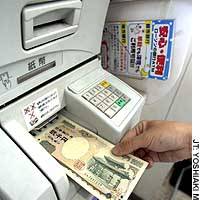How often do you come across a 2,000 yen bank note?
Introduced amid much fanfare in 2000, the 2,000 yen bill still seems like a novelty to many consumers.
In fact, more 2,000 yen bank notes are in circulation than veteran 5,000 yen bills.
"Times have changed," said a Finance Ministry official, recalling that for some time after the bill's debut, the ministry was paying a portion of officials' salaries with 2,000 yen bills to boost their circulation.
The number of 2,000 yen bank notes in circulation reached 480 million in April, surpassing the 470 million 5,000 yen bills in circulation, according to the Bank of Japan.
"We are intentionally supplying more 2,000 yen bank notes than others to increase their circulation as a way of preventing counterfeit notes," a BOJ official said.
The 2,000 yen bill, the nation's newest bill, features the latest anticounterfeit measures, including special inks.
This same technology, however, also deters widespread use of 2,000 yen notes; many ticket machines and automated teller machines have yet to be upgraded to accept 2,000 yen bills due to the high costs involved, the BOJ official said.
But where are they being circulated?
Most of the 2,000 yen bills in circulation are probably traveling back and forth between banks and retailers as consumers don't want to hang on to them due to their inconvenience, the official said.
According to convenience store operator Lawson Inc., many customers use 2,000 yen bank notes soon after withdrawing them from in-store ATMs. Some customers even refuse to receive 2,000 yen bills as change, it said.
The BOJ expects more and more ATMs and ticket machines to be upgraded to accept 2,000 yen bank notes as early as the fall, when 1,000 yen, 5,000 yen and 10,000 yen bills are all scheduled to be renewed with new anticounterfeit features, the official said.


















With your current subscription plan you can comment on stories. However, before writing your first comment, please create a display name in the Profile section of your subscriber account page.